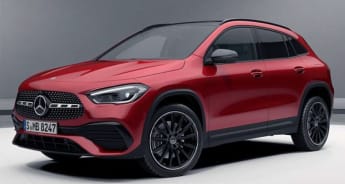ONE of the great motoring successes of the past decade has been the Mercedes-Benz GLA, catapulting the brand to unparalleled prominence in the premium small SUV field and kicking off the posh little coupe-hatch crossover craze.
Cynics might say that it is essentially a jumped-up A-Class hatchback, much like the Subaru XV is basically an Impreza in stilettos. But while the small German crossover is built on the same MFA2 platform as its smaller transverse-engined Benz brethren, no body panels are shared, granting it a distinct look and personality. Unlike the little Suby…
The H247-series GLA launched in Australia in 2020 is second-generation, featuring a longer wheelbase and appreciably more space, but a shorter overall length than the popular original from 2013. It's also substantially taller.
Here we take a long, hard look at the bestselling GLA 250 4Matic.
Mercedes-Benz GLA 2021: 250 4Matic
| Engine Type | Turbo 4, 2.0L |
|---|---|
| Fuel Type | Premium Unleaded Petrol |
| Fuel Efficiency | 7.5L/100km (combined) |
| Seating | 5 |
| Price From | $61,930 - $71,170 |
Does it represent good value for the price? What features does it come with?
The latest GLA’s evolved dimensions is presumably to put some space between it and its GLB 5+2-seater SUV fraternal twin, giving Mercedes-Benz blanket SUV market coverage. From GL (for Geländewagen, or off-road vehicle) A, B, C, E and S (as well as the G-wagen icon that started it all back in '79), there’s a premium option for everybody… if not every budget.
In the GLA’s case, the entry-level 200 front-driver starts from $55,100 (before on-road costs); moving up to the $66,500 250 4Matic, and then to two performance powerhouses – the AMG 35 4Matic and supernaturally fast AMG 45 S 4Matic+ flagship, from $82,935 and $107,035 respectively.
Even the base GLA 200 includes new and improved autonomous emergency braking (AEB) among other safety-related technologies, as well as the brand’s glamorous MBUX multimedia system with wireless Apple CarPlay/Android Auto, digital radio, satellite navigation, reverse camera, climate control, wireless phone charging, powered tailgate, automatic parking, auto high beam, rain-sensing wipers and 19-inch alloys.

All the extra techy stuff doesn’t come for free though – prices jump almost $10,000 over the less-powerful previous-generation GLA 180 that the 200 replaces – though we expect the former badge to return in time.
In contrast, the GLA 250 4Matic is ‘only’ $3500 more expensive than its predecessor, gaining a terrific 2.0-litre four-cylinder turbo instead of a Renault-Nissan-sourced 1.3-litre turbo, all-wheel drive (with an Off-Road Engineering Package that gives the car some very light off-road capability), and other niceties such as heated electric front seats with memory function, a panoramic sunroof, more direct steering and lowered suspension (for a sportier drive).
Note that adaptive cruise control costs extra – a curious oversight at this price point. It’s part of a $1531 optional Driving Assistance Package, which also includes Active Lane Change Assist, extended semi-autonomous driver assistance in traffic jams (meaning full stop/go capability) and route-based speed adaptation. Do it.

Our test car had it, along with a $915 Vision Package (includes fancier adaptive headlights and a 360-degree camera), $1915 Sports Package (with AMG styling upgrades inside and out, perforated disc brakes, privacy glass, shift paddles and lowered ‘Comfort Suspension’), a Night Package (less brightwork, more black finishes) and sports direct-steering with corresponding wheel), $1531 20-inch AMG Black alloys, a $1915 Communications Package with upgraded audio and head-up display among a litany of other gear, $2838 AMG Exclusive Package with adaptive dampers, cooled as well as heated front seats, an ‘Energising Comfort’ ambience-enhancing 'experience' and special leather upholstery, $1531 Patagonia Red metallic paint and $607 rear-seat fore/aft adjustment. Total cost after the added luxury car tax: $82,446. Gulp.
Not cheap in anybody’s language. Nor, for that matter, are the GLA’s rivals, which owe their existence to the original’s spectacular sales trajectory and the trail that this blazed last decade.

Lexus’ loaded UX 250h hybrid AWD and Audi Q3 Sportback 40TFSI quattro slip slightly below the standard GLA 250 for both pricing and power, while the BMW X2 M35i and its Mini Countryman JCW cousin, along with Jaguar’s E-Pace E250, also offer in-the-same ballpark pricing but quite a bit more space as well as pace.
It’s also worth noting that Volvo’s XC40 T5 AWD conspicuously undercuts all from just $57,000, though now we’re talking about putting square pegs into round holes. Speaking of which…
Is there anything interesting about its design?
Looking like a mini-me GLC, today's GLA trades some of its predecessor’s edgier design elements like the slammed roof and exaggerated broad-shouldered stance for a more amorphous if elegant appearance. Even with the cliché plastic cladding around the squared-off wheel arches, it’s still a looker.
The net result is arguably the most attractive of all the MFA2 A-Class offshoots. It sits well within the Mercedes hierarchy of SUVs, bringing a swoopy coupe-like silhouette compared to the ultra-upright GLB.
Along with being 30mm wider, it’s also visibly taller than before, with a handy 213mm of ground clearance compared to just 157mm last time around. And the wheelbase has been stretched to the benefit of rear-passenger room – a bugbear of the old GLA. That's progress.

How practical is the space inside?
Compared to before, the 2021 GLA is some 122mm taller, so ushers in a higher hip point for loftier seating – reducing that jumped-up hatch feel. Headroom improves obviously, as does rear legroom, a corollary of a 30mm wheelbase stretch (to 2729mm).
Wide apertures also make entry into and out of the German-built GLA child's play, though the solid heft of their doors is serious business at this end of the segment, very satisfyingly Teutonic and totally on-brand. This is something you won’t enjoy in a Subaru XV.
Then you s-c-r-a-p-e the underside of the front doors on the pavement literally every time you swing it to get out, and wonder whether Mercedes engineers have ever been to Australia. This fail drove us spare. Heaven help the GLAs in towns and cities with bluestone sidewalks. Maybe all that extra AMG packaging is the culprit.

Still, most of the other basics are spot-on and can’t really be faulted; cosy yet spacious for four adults – especially up front, ample vision, an excellent driving position aided by heaps of seat and steering wheel adjustability, cosseting front sports buckets that you just sink into, torrents of ventilation from those delectable turbine vents and stacks of storage. Collectively they make the GLA a welcoming, opulent place to travel in. Only the hapless fifth occupant squished between the outboard rear-seat passengers might think otherwise. But nobody buys this Benz for carting people around. That's the GLB's job.
Several years ago, Daimler poached a senior Audi designer and since then Mercedes’ dashboards have morphed into a multi-coloured multimedia diorama of touchscreen technology that threatens to completely take over the universe. Choose the right combination of colours and lighting and it's like your very own White Night on wheels. Starting with 2018’s A-Class, the striking, spangly MBUX system that underpins all this has come to be widely admired and imitated. For aesthetics anyway, with its vivid hues, panoramic displays and simple, tiled applications, it’s been a real trip.
Anyway, back to reality. From a tactility and functionality point of view, there’s still work to be done.

Access to the multimedia (including our GLA's banging optional audio system) and car settings areas is possible via a mildly fiddly finger-pad arrangement down forward in the centre console, or smaller yet much more annoying thumb sensor tabs on the wheel spokes. These are not easy to modulate on the move. Additionally, their menus can be confusing to navigate through and sometimes counterintuitive in operation. Mercedes obviously realises this as a quick-guide pamphlet is provided on old-fashioned cardboard paper. How quaint.
Eventually all areas can be mastered over time, but the functionality is complicated and may overwhelm the not-so-tech savvy. Additionally, the ‘Hey, Mercedes!’ voice control is impressive for getting MBUX to perform basic multimedia and vehicle settings-related changes, but it too-often erratic, unreliable and ultimately frustrating for more complicated commands. Perhaps elocution lessons on behalf of the operator may help.
But not as much as the profound disappointment we endure from the cheapness of some of the materials, the wincing cellophane-like sounds when pressing on some of the surfaces such as the door cards, or that emanate after a particularly bumpy section of bad roads. Sheeny reflections and hard textures in a car optioned with extras that total up to nearly $82,500 just don’t cut it.
At least in this latest-gen GLA, the rear seat area seems much improved over the previous models, with more space, comfy and supportive seating (remember ours featured the $607 sliding function that ought to be standard) and a reclining backrest. All amenities are present, with deep pockets, fresh air from twin vent outlets, reading lights and thoughtfully placed armrests – but, again, the latter’s extendable cupholders feel brittle and cheap.
Further back, the 435-litre cargo area is sufficiently sized and practical for smaller family use (at last), aided by a 40/20/40 backrest fold and that slide-able cushion to extend capacity further. There is no spare wheel, but a tyre inflation kit is fitted in lieu.
Overall, then, better than before, with that fundamental rock-solid heft, luxurious aura and alluring premium-car aroma. The dazzling MBUX screen-related visuals, too, are endlessly entertaining to explore when the vehicle is not moving, but the GLA’s cabin is still not quite up to Mercedes’ reputation for exacting over-engineered excellence.
Or even to the standards of some mainstream alternatives.
What are the key stats for the engine and transmission?
Mounted transversely, Mercedes’ M260 1991cc 2.0-litre four-cylinder petrol engine features a twin-cam, 16-valve design, a twin-scroll turbocharger and variable-valve timing, to help deliver 165kW of power at 5500rpm and 350Nm of torque at a low 1800rpm. With an impressive 97.2kW per tonne, it can hit 100km/h in 6.7 seconds, on the way to a 240km/h top speed.
All four wheels are driven by an eight-speed dual-clutch transmission (DCT), though most of the torque at lower speeds or during reduced throttle loads is delivered to the front wheels until extra traction is required out back. The gearbox is one of the very best of its type we’ve experienced – seamless, strong and largely lag-free.

How much fuel does it consume?
Weighing in at 1668kg (kerb), and with a bluff nose and high ground clearance also not helping, we didn’t expect great fuel economy, particularly given how hard and fast the GLA 250’s performance bandwidth is. It’s tempting to just blast your way from point A to point B.
However, at the pump we averaged 9.8 litres per 100km, which isn’t too bad at all considering the available muscle. The official figure is 7.5L/100km, for a carbon dioxide emissions rating of 170 grams per kilometre. With a 51-litre fuel tank, the theoretical range is around 680km.
Note that the GLA 250 requires 95 RON premium unleaded petrol as a minimum.
Warranty & Safety Rating
What safety equipment is fitted? What safety rating?
Mercedes-Benz is a long and proud pioneer in passenger-vehicle safety, and the GLA is no exception… except that for the full suite of safety assistance you need to fork out more in the GLA 250.
The standard roll-call of advanced driving assist systems includes nine airbags (front, pelvis side and window bags for driver and front passenger, side airbags for rear occupants and a knee airbag for the driver), AEB with pedestrian and cyclist detection, and blind-spot monitoring with an exit warning that alerts the driver of approaching cyclists or vehicles if the door begins to open into their path.
The AEB system has a working range of between 7km/h and 200km/h.

Active Lane Keep Assist, an active bonnet that raises to reduce head injury, Cross Wind Assist, Pre-Safe accident anticipatory systems and traffic sign recognition tech are also present.
Additionally, front and second-row seatbelt reminders are fitted, as well as two rear-seat sited ISOFIX child-seat anchorage points and a trio of child-seat tether points behind the backrest.
But you’ll need to fork out another $1531 for the optional Driving Assistance Package, which includes adaptive cruise control with full-stop/go, Active Lane Change Assist, extended semi-autonomous driver assistance in traffic jams, and route-based speed adaptation.
At the time of publishing, the H247-series GLA’s crash test rating results had not been published, but the closely-related GLB tested in 2020 managed a full five stars.
What does it cost to own? What warranty is offered?
Unlike many luxury brands that persist with a sub-par three-year warranty, Mercedes-Benz offers a five-year/unlimited kilometre warranty.
Intervals are every year or 25,000km, with a capped price service plan starting at $550 for the first year, $750 for the second year and $1250 for the third year, totalling $2550. Alternatively, buyers can also choose a Service Plan, starting at $2050 for the first three years (saving $500 from the normal capped-price service plan), $2950 for four years and $3500 for five years.
What's it like to drive around town?
A soaring 2.0-litre turbo engine application, this is a slick, stirring and robust performer that can also do efficiency as effortlessly as launch the GLA 250 4Matic towards the horizon. Let’s not mince our words. This is a fast and fiery mover.
Three drive modes – Eco, Comfort and Sport – provide a wide spectrum of acceleration and throttle responses, and all deliver precisely what you’d expect. Eco’s fine for pottering around town smoothly and serenely; Sport morphs into a searing and seamless speed demon; and the default Comfort sits somewhere in the middle as the best of both worlds. There really is no faulting Mercedes’ M260 masterpiece.
The DCT also happens to be one of the better dual clutch autos, avoiding the lag and clunkiness pitfalls usually associated with this sort of gearbox. It’s even comparatively smooth off the line on hills. Ours came with the optional handy set of manual-mode paddle shifters, adding a welcome level of interactivity autos tend to overlook. Too bad Mercedes persists with that fiddly column lever that is forever prone to knocking the car out of drive. Even after 15 years, it's still so annoying.

What all this means for the urban driver is strong acceleration for flitting in and out of traffic gaps, as well as incredibly instantaneous point-to-point responses for commanding manoeuvrability, thanks to ultra-eager steering and assisted by outstanding brakes.
With struts up front and a multi-link rear end as standard, the GLA 250’s chassis, too, is a transformative for what is essentially a high-riding hatchback – but only if your pockets are deep enough.
Fitted with that near-$3K AMG Exclusive Package that includes adaptive dampers, our Benz displayed a definite hot-hatch attitude that really would make it the darling of Golf GTI owners who’ve outgrown their rides but not their girl/boyracer desires. Superb handling and hunkered-down roadholding really do make this the driver’s premium compact crossover. You can pretty much point and shoot this Merc as you might a Golf R, and likewise in most weather conditions thanks to all that reassuring tenacious grip.

Plus, if you’re put off by the hard ride in Sport, the Individual mode allows the driver to engage the soft damper mode while the engine and steering retain the hardcore settings. It’s a win-win situation – as long as you can stretch to that AMG Exclusive pack. We strongly recommend it, given the balance between ultimate high-speed control and comfort.
However, while this is all good news for rural and country folk seeking hot crossover fun, back around town, poor urban road conditions can reveal a flaw in the chassis’ ability to properly smother bumps and ruts. It’s the small frequency stuff that seems to transmit through, never really settling down.
The result is a jittery ride, that may somewhat undermine the GLA’s upmarket sheen. There’s also a fair degree of road noise coming through. Perhaps sticking with the 19-inch alloys instead of those lovely 20-inch rims is the solution here.
Verdict
With Mercedes-Benz’s vast number of SUVs, there is room for an urban luxury crossover niche, and the GLA delivers in spades.
Indeed, in 250 4Matic guise, it is that rare thing – a high-riding hatch with dynamics to shame most dedicated pocket-rockets. It really is a hoot if you find the right road, regardless of weather conditions. The Benz has towering talent.
However, even without desirable options like adaptive dampers and a full suite of driver-assist safety technology, the GLA is expensive, does not quite carry off the price tag from an interior quality point of view, and struggles to maintain the degree of comfort and refinement expected from a Mercedes – with or without the $3K necessary to score adaptive dampers.
Still, especially because of the way the GLA looks, goes, stops and steers, if you can afford it, you’ll be rewarded. There’s never been a more rounded GLA.
Pricing Guides

































.png)








.jpg)
.jpg)
.jpg)



